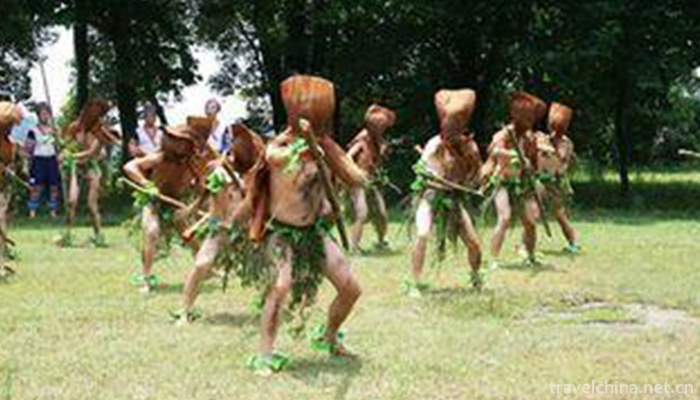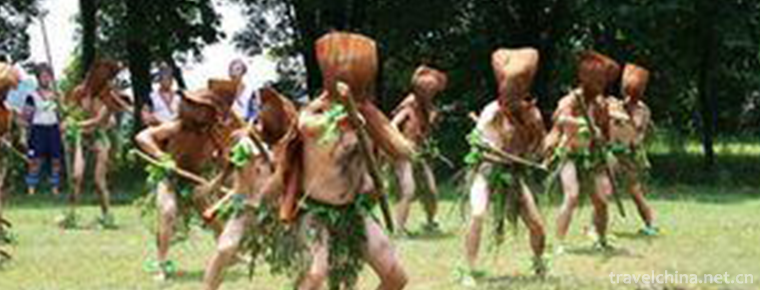Zong Baonao
Zong Baonao
The dance used for sacrifice - the Yao Zong Baonao Dance is evolved from an ancient legend. According to Changtang Yao people, from generation to generation, in ancient times, a beautiful Yao mother lived on Xuefeng Mountain, once captured by ferocious mountain ghosts while picking fruits. Her son was determined to save his mother by fighting ghosts. He worshiped Meishan God as a teacher and practiced his ability of catching ghosts and eliminating devils. In order not to be noticed by the mountain ghosts, he wrapped his head with brown pieces and experienced many dangers. With the help of Sandong Meishan God, he defeated the mountain ghosts and rescued his mother. In order to praise the great filial virtues of ancestors seeking their mothers and saving their mothers and filial piety, Yao descendants hold grand sacrificial ceremonies in the first month of each year, dancing the "brown brains" dance, singing praises, offering sacrifices to ancestors and praying for the future.
For the performance procedure of "Brown Brain", it can be divided into "sacrifice", "single-stick performance", "double-stick performance", "bench skill", "Meishan handstand", "ghost driving, beast fighting" and "celebration". For its preparation, a table should be placed in the center of the venue to offer tribute such as bamboo buns and peaches. When the incense and candles were lit, Yao Laoyin sounded the horn of a bull toward the sky, and "Brown Brain" held the stick and shouted forward, then swung the stick and walked, half bowed body, holding the stick in both hands as a cudgel, very pious. For each paragraph of the performance, there are many details. For example, when performing a double-stick show, two people need to shake the stick and oppose each other. You attack and defend against us. "Bench skill" is the routine used by Dai Chang Road in the past, but the scenes of "Meishan inverted", "exorcising ghosts and beating wild animals" are seldom seen now. According to the rules, the last thing to do is to build a fire and jump out. The whole activity will not end until very late.
For the movements of brown brain dance, most of them are original dance movements such as head swing, arm swing, club, waist twisting, foot stamping, left and right pause, which are concise, clean, rough and powerful. For its manifestation, it can be divided into single, double, multi-person and bench performances. The part of dance action can be roughly divided into multi-person performance and double stick performance. The dancing action of brown brain-wrapped dance is based on the movement of clubs, which is simple and simple without lack of rich significance.
It is reported that although the "brown enclosed brain" dance has a long history, interpreting the unique ancient Yao people's sacrifice and filial piety culture, but because of the deep mountains, it has been full of mysterious color in the outside world. However, it has distinct local ethnic characteristics and strong local flavor. It has important reference value for the study of folk literature, ethnology, folklore and Yao people's living customs in Southwest Hunan, as well as for the study of Meishan culture and Nuo culture. Its excavation is of great significance for people to trace back and explore the origin, development and evolution of ancient Yao dance and ancient martial arts dance.


-
1.Kaifeng soup dumplings
Kaifeng filling soup bag is one of the famous foods in Kaifeng because of its unique flavor. The soup is thin and white like Jingdezhen ceramics. It has a transparent feeling
Time 2018-11-26 -
2.Kizil Gaha Peak Sui
Located on the east side of Saltwater Valley in the northwest of Kuqa County Town, Kizil Mahabi is a towering ancient military building with the meaning of "old red mouth" or "red sentr
Time 2018-12-23 -
3.Taierzhuang Ancient City Scenic Area
Taierzhuang Ancient City, located at the center of the Beijing-Hangzhou Grand Canal, is located at the junction of Taierzhuang District, Zaozhuang City, Shandong Province
Time 2019-02-13 -
4.Mount Tais Flower Age
Taishan Flower Age Scenic Area in Tai'an City, Shandong Province, is a large-scale agricultural tourism cultural project with five functions of entertainment, sightseeing, picking, catering
Time 2019-02-13 -
5.Song and dance duet
Errentai is commonly known as Dual Items, two classes. Originated in Shanxi and growing up in Inner Mongolia, it is a traditional opera popular in the central and Western Inner Mongolia Autonomous Reg
Time 2019-04-29 -
6.Wuqiao acrobatics
Wuqiao acrobatics is a traditional folk acrobatics art in Hebei Province. Referring to the "acrobatics town" people are often referred to as Wuqiao County, Cangzhou City, Hebei Province. Acc
Time 2019-06-29 -
7.Guangxi drama
One of the local operas of the Zhuang nationality in Guangxi. Yongju Opera belongs to the Pihuang Vocal Tune System, which originated in Hunan. It was formerly called Guangju Opera, Old Opera, Local O
Time 2019-07-14 -
8.Zhangzhou Woodblock New Year Picture
Zhangzhou woodcut New Year pictures belong to folk art, which began in the Song Dynasty and flourished in the Ming and Qing Dynasties. The contents of the New Year pictures are mainly two categories:
Time 2019-07-25 -
9.Brick and plastic
Brick sculpture is the handicraft of folk craftsmen. It is made of mud into various animal models. Some of the images are realistic, but more are romantic and exaggerated ways of expression, the shape
Time 2019-08-10 -
10.Chengdu University of Information Technology
Chengdu University of Information Engineering is a provincial general undergraduate college jointly established by Sichuan Province and China Meteorological Bureau and the key development of Sichuan P
Time 2019-08-31 -
11.Mount sanshen
The three sacred mountains in Yading, Daocheng, are composed of three snow peaks, xiannairi, yangmaiyong and xianodoji, representing respectively Guanyin Bodhisattva, Manjusri Bodhisattva and Vajrayana Bodhisattva.
Time 2020-10-13 -
12.Thanksgiving tower
Baoen tower is located in Baoen tower Cultural Square, Jiangyang District, Luzhou City, Sichuan Province, commonly known as Luzhou white tower. It is one of the cultural relics under key protection in Luzhou city. Its unique "white pagoda dawn" is one of the "Eight Sights of Luzhou".
Time 2020-10-15